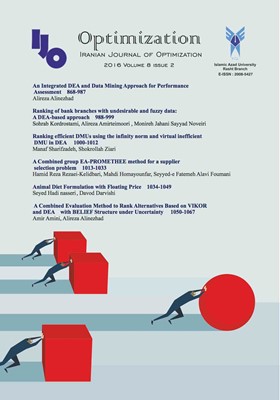Ranking of bank branches with undesirable and fuzzy data: A DEA-based approach
Subject Areas : Data Envelopment AnalysisSohrab Kordrostami 1 * , Alireza Amirteimoori 2 , Monireh Jahani Sayyad Noveiri 3
1 - Lahijan Branch, Islamic Azad University
2 - Rasht Branch, Islamic Azad University
3 - Lahijan Branch, Islamic Azad University
Keywords: Data Envelopment Analysis (DEA), Ranking, undesirable data, bank branches performance, fuzzy data,
Abstract :
Banks are one of the most important financial sectors in order to the economic development of each country. Certainly, efficiency scores and ranks of banks are significant and effective aspects towards future planning. Sometimes the performance of banks must be measured in the presence of undesirable and vague factors. For these reasons in the current paper a procedure based on data envelopment analysis (DEA) is introduced for evaluating the efficiency and complete ranking of decision making units (DMUs) where undesirable and fuzzy measures exist. To illustrate, in the presence of undesirable and fuzzy measures, DMUs are evaluated by using a fuzzy expected value approach and DMUs with similar efficiency scores are ranked by using constraints and the Maximal Balance Index based on the optimal shadow prices. Afterwards, the efficiency scores of 25 branches of an Iranian commercial bank are evaluated using the proposed method. Also, a complete ranking of bank branches is presented to discriminate branches.
Adler, N., Friedman, L., & Sinuany-Stern, Z. (2002). Review of ranking methods in the data envelopment analysis context. European Journal of OperationalResearch, 140(2) ,249-265.
Alirezaee, M. R., & Afsharian, M. (2007). A complete ranking of DMUs using restrictions in DEA models. Applied MathematicsandComputation, 189(2) 1550-1559.
Amirteimoori, A., Kordrostami, S., & Khoshandam, L. (2014). Multi-dimensional non-discretionary factors in production processes: a data envelopment analysis.IMA Journal of Management Mathematics, 25(4) ,435-448.
Asmild, M., & Tam, F.(2007). Estimating global frontier shifts and global Malmquist indices, Journal of Productivity Analysis, 27(2) ,137-148.
Camanho, A.S., & Dyson, R.G.(1999). Efficiency, Size, Benchmarks and Targets for Bank Branches: An Application of Data Envelopment Analysis.The Journal of the Operational Research Society, 50(9) ,903-915.
Gaganis , C., Liadaki, A., Doumpos, M., & Zopounidis, C. (2009). Estimating and analyzing the efficiency and productivity of bank branches: Evidence from Greece. Managerial Finance, 35(2) ,202-218.
Guo, D., & Wu, J. (2013). A complete ranking of DMUs with undesirable outputs using restrictions in DEA models. Mathematical and Computer Modelling, 58(5-6) ,1102-1109.
Hatami-marbini, A., Emrouznejad, A., & Tavana, M. (2011). A taxonomy and review of the fuzzy DEA literature: Two decades in the making. European Journal of OperationalResearch, 214(3) ,457-472.
Jahanshahloo, G.R., Hosseinzadeh Lotfi, F., Sanaei, M., & Fallah Jelodar, M. (2008). Review of ranking models in data envelopment analysis. Applied Mathematical Science, 2(29) ,1431-1448.
Liu, B., & Liu, Y. K. (2002). Expected value of fuzzy variable and fuzzy expected value models. IEEE Transactions on Fuzzy Systems, 10(4) ,445-450.
McEachern, D., & Paradi, J.C.(2007). Intra- and inter-country bank branch assessment using DEA.Journal of Productivity Analysis, 27(2) ,123-136.
Mitropoulos, J., Anastasiou, A., Sissouras, A.(2003). Managing cost efficiency of bank branches : an empirical study for the “Commercial Bank of Greece”. Journal of Interdisciplinary Mathematics, 6(1) ,1-17.
Noulas, A.G., Glaveli, N.,& Kiriakopoulos, I. (2008). Investigating cost efficiency in the branch network of a Greek bank: an empirical study. Managerial Finance, 34(3) 160-171.
Parkan, C. (1987). Measuring the efficiency of service operations: an application to bank branches. Engineering Costs and Production Economics, 12(1-4) ,237-242.
Pastor, J.T., Lovell, C.A.K., & Tulkens, H. (2006). Evaluating the financial performance of bank branches. Annals of Operations Research, 145(1) ,321-337.
Puri, J., & Yadav, S.P. (2014). A fuzzy DEA model with undesirable fuzzy outputs and its application to the banking sector in India. Expert Systems with Applications, 41(14) ,6419-6432.
Sherman, H.D., & Gold, F. (1985). Bank branch operating efficiency: Evaluation with data envelopment analysis. Journal of banking & finance, 9(2) 297-315.
Wang, Y. M., & Chin, K.S. (2011). Fuzzy data envelopment analysis: A fuzzy expected value approach. Expert Systems with Applications, 38(9) ,11678-11685.
Wu, J., Yang, F., Liang, L. (2010). A modified complete ranking of DMUs using restrictions in DEA models. Applied MathematicsandComputation, 217 (2) 745-751.

